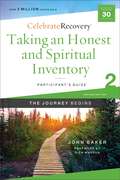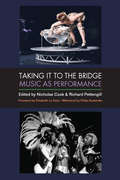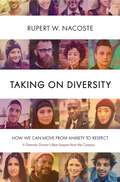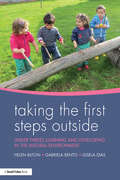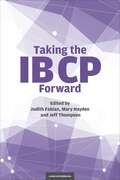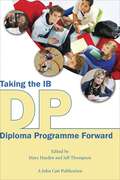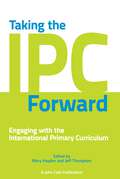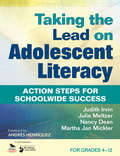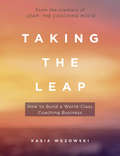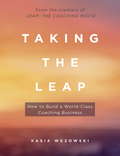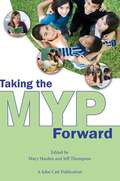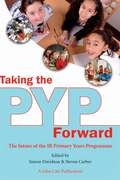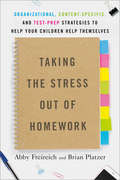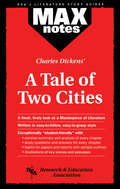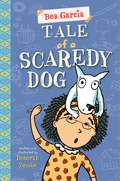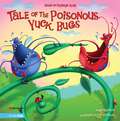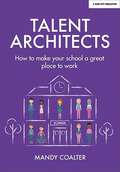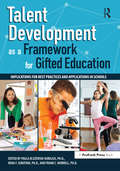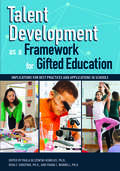- Table View
- List View
Taking an Honest and Spiritual Inventory Participant's Guide 2: A Recovery Program Based on Eight Principles from the Beatitudes (Celebrate Recovery)
by John BakerThe Celebrate Recovery Participant's Guides are essential tools for the personal recovery journey. In the five lessons in Guide 2: Taking an Honest and Spiritual Inventory, you will experience an in-depth look at the 4th principle in the recovery process:4 Openly examine and confess my faults to God, to myself, and to someone I trust. "Happy are the pure in heart" (Matthew 5:8).By working through the lessons and exercises found in each of the four Participant's Guides you will begin to experience the true peace and serenity you have been seeking, restore and develop stronger relationships with others and with God, and find freedom from life's hurts, hang-ups, and habits. All the scriptures have been updated to the new NIV 2011 version.
Taking it to the Bridge: Music as Performance
by Nicholas Cook Richard PettengillThe overriding aim of this groundbreaking volume--whether the subject is vocal ornamentation in 19th-century opera or the collective improvisation of the Grateful Dead--is to give new recognition to performance as the core of musical culture. The collection brings together renowned scholars from performance studies and musicology (including Philip Auslander, David Borgo, Daphne Brooks, Nicholas Cook, Maria Delgado, Susan Fast, Dana Gooley, Philip Gossett, Jason King, Elisabeth Le Guin, Aida Mbowa, Ingrid Monson, Roger Moseley, Richard Pettengill, Joseph Roach, and Margaret Savilonis), with the intent of sparking a productive new dialogue on music as performance. Taking It to the Bridge is on the one hand a series of in-depth studies of a broad range of performance artists and genres, and on the other a contribution to ongoing methodological developments within the study of music, with the goal of bridging the approaches of musicology and performance studies, to enable a close, interpretive listening that combines the best of each. At the same time, by juxtaposing musical genres that range from pop and soul to the classics, and from world music to games and web-mediated performances, Taking It to the Bridge provides an inventory of contrasted approaches to the study of performance and contributes to its developing centrality within music studies.
Taking on Diversity: How We Can Move from Anxiety to Respect
by Rupert W. NacosteIn this enlightening book, a campus "diversity doctor" relatesstories that individuals have shared with him about their anxieties in situations involving people who are in some way different than themselves. Dr. Rupert W. Nacoste regularly counsels students at North Carolina State University about their problems dealing with diversity of all kinds, including of gender, race, ethnicity, and sexual-orientation. Here, he shares his most effective techniques for handling the unavoidable realities of being in a neo-diverse community, whether that means in college or America as a nation. The author's proven "safe space" strategy can be applied to the campus, community groups, churches, and workplaces as a means to facilitate positive dialogue about diversity. In this time of current tensions, students, or "young travelers" as Nacoste fondly refers to them, still have much work ahead of them to achieve mutual respect and understanding. From everyday encounters, parties, and email and social media exchanges, they provide examples of ongoing bigotry: racial slurs and stereotypes are still used; young men continue to project demeaning attitudes toward women; and the heterosexual majority sometimes shows little understanding of the LBGT minority. Dr. Nacoste considers it his role to usher students off the "Wrong-Line train," and he has noticed that as they "leave the station," adults begin to follow their lead. The author demonstrates how we can maintain fairness and respect while still acknowledging our differences. By doing so, we can all learn to meet these challenges using sensitivity to different perspectives, open-minded attitudes, and the recognition that diversity in America is here to stay.
Taking the First Steps Outside: Under threes learning and developing in the natural environment
by Helen Bilton Gabriela Bento Gisela DiasCan one be too young to play outside? This unique and compelling book charts the experiences of a group of under-three-year-olds as they explore their natural outdoor environment, followed by caring and attentive adults. It deconstructs the myths that underestimate under threes and celebrates the importance of connecting children with the natural world and the influence of positive relationships in this early stage of life. Taking the First Steps Outside draws on all aspects of working outdoors, focusing on different steps of the project, main achievements and obstacles, implemented strategies and benefits for the development of young children. Features include: Stunning photographs of children exploring the outdoor environment, who are interested, thoughtful, persistent and successful Detailed descriptions of real events, illustrating how the outdoor space can be an educational context for under threes Insight into the role of the adult, as they observe and reflect upon children’s learning Advice on choosing the right resources and facilities to create a good outdoor learning environment for the young child Advice about risky play and promoting challenging and positive opportunities in the natural environment Guidance on how to set up an outdoor project for children under three Written to support all students, teachers, practitioners and managers working with under threes, this essential guide will help you to develop your knowledge, build confidence and gain the ability to co-explore outdoors with children.
Taking the IB CP Forward (Taking it Forward)
by Mary Hayden Jeff Thompson Judith FabianThe IB Career-related Programme for 16 to 19 year olds was launched in 2012. Designed for young people who want to prepare for a career and the world of work alongside their academic studies, this innovative programme adds a new dimension to an IB education, opening it up to a wider range of student needs and aspirations. This edited collection provides ideas and support for those involved in implementing the CP, or planning to introduce it in the future. The chapters are written by practitioners, some of whom have been involved with the CP from its earliest days, who provide forthright accounts of the significant rewards the introduction of the CP has brought to their students. Taking the IB CP Forward explores the key elements of the programme, its flexibility and how it can implemented to meet the needs of a range of educational contexts. Contributors: Dominic Robeau, Theresa Forbes, Chantell Wyten, Cathryn Berger Kaye, Patrick Daneau, Alexandra Juniper, Sara Woodcock, Ramona Dietrich, Mike Worth, Catheryn Phipps-Orive, Paul Campbell, Natasha Deflorian, David Barrs, Tony Smith, Kate Greig, John Carozza, Conan de Wilde, Peter Kotrc, Julia Peters, Stewart Redden, John Bastable.
Taking the IB CP Forward (Taking it Forward)
by Mary Hayden Jeff Thompson Judith FabianThe IB Career-related Programme for 16 to 19 year olds was launched in 2012. Designed for young people who want to prepare for a career and the world of work alongside their academic studies, this innovative programme adds a new dimension to an IB education, opening it up to a wider range of student needs and aspirations. This edited collection provides ideas and support for those involved in implementing the CP, or planning to introduce it in the future. The chapters are written by practitioners, some of whom have been involved with the CP from its earliest days, who provide forthright accounts of the significant rewards the introduction of the CP has brought to their students. Taking the IB CP Forward explores the key elements of the programme, its flexibility and how it can implemented to meet the needs of a range of educational contexts. Contributors: Dominic Robeau, Theresa Forbes, Chantell Wyten, Cathryn Berger Kaye, Patrick Daneau, Alexandra Juniper, Sara Woodcock, Ramona Dietrich, Mike Worth, Catheryn Phipps-Orive, Paul Campbell, Natasha Deflorian, David Barrs, Tony Smith, Kate Greig, John Carozza, Conan de Wilde, Peter Kotrc, Julia Peters, Stewart Redden, John Bastable.
Taking the IB Diploma Programme Forward (Taking it Forward)
by Mary Hayden Jeff ThompsonExpert writers share their thoughts and opinions on the future of the International Baccalaureate Diploma Programme. The editors and contributors, all experts in their field, identify issues arising from current practice and indicate how those issues need to be addressed as part of a policy for future growth.
Taking the IB Diploma Programme Forward (Taking it Forward)
by Mary Hayden Jeff ThompsonExpert writers share their thoughts and opinions on the future of the International Baccalaureate Diploma Programme. The editors and contributors, all experts in their field, identify issues arising from current practice and indicate how those issues need to be addressed as part of a policy for future growth.
Taking the IPC Forward: Engaging with the International Primary Curriculum
by Mary Hayden Jeff ThompsonSince its introduction in 2000, well over 1000 schools in more than 65 different countries have adopted the IPC. In this book, educators raise and discuss implications for the future implementation of this innovative curriculum within the context of a changing world.
Taking the IPC Forward: Engaging with the International Primary Curriculum
by Mary Hayden Jeff ThompsonSince its introduction in 2000, well over 1000 schools in more than 65 different countries have adopted the IPC. In this book, educators raise and discuss implications for the future implementation of this innovative curriculum within the context of a changing world.
Taking the Lead on Adolescent Literacy: Action Steps for Schoolwide Success
by Judith Irvin Nancy Dean Julie Meltzer Martha Jan Mickler"This rich resource walks middle and high school literacy leaders through a comprehensive process for conceptualizing, initiating, and, most important, sustaining a schoolwide literacy learning program. The authors clearly know teachers and schools, and their reality-tested tools will prove invaluable in guiding and supporting middle and high school literacy leaders."—Doug BuehlAuthor, Classroom Strategies for Interactive LearningA systemic and sustainable approach for improving adolescent literacy and learning!Taking the Lead on Adolescent Literacy provides educational leaders with a user-friendly and comprehensive planning process for developing a new literacy initiative—or for dramatically enhancing a current plan--that has the power not only to raise student performance levels but also to positively impact graduation rates, employability, and higher education success.Using a five-stage framework that has been field-tested nationwide for more than a decade, the authors provide an array of resources to guide in-depth planning, implementation, and monitoring to ensure sustained results, supported by examples from literacy-rich schools, checklists and assessments, and a glossary of terms. Each stage in the process builds upon a school or district′s existing capacities and focuses on six detailed rubrics that can be implemented at every stage to help ensure long-term success:Student motivation and engagement Literacy across the content areas Literacy interventions Literacy-rich environment, policies, and culture Parent and community involvement District support of school-based effortsHelping educators build the critical skills in students for communicating and making meaning within an increasingly complex world, this book shows how a sustained focus on literacy can serve as a powerful lever for school improvement.
Taking the Leap: How to Build a World-Class Coaching Business
by Kasia WezowskiOrganized into three sections: Finding Yourself and Your Purpose, Finding Your Clients, and Finding Success, Taking the Leap provides relevant and practical advice from twenty-four well-known coaches who have built sustainable coaching businesses whole doing what they love-helping people.Success tips and strategies from global, coaching masters infused with their own personal accounts of how they got their start:MARSHALL GOLDSMITH on becoming a better businesspersonJACK CANFIELD on continuous improvementKIERON SWEENEY on promoting yourselfHEATHER RAMSEY on selecting a business modelMARK THOMPSON on partnering with industry leaders and influencersKELVIN LIM on specializationJOHN DEMARTINI on putting your mission firstPATRYK WEZOWSKI on scaling your businessMARC STEINBERG on inner wisdomMIRNA BACUN on leveraging LinkedInVISHEN LAKHIANI on building a visionary business
Taking the Leap: How to Build a World-Class Coaching Business
by Kasia WezowskiMake your mark as a coach and grow your business by learning from the best, highest-level coaches in the world who are willing to share their secrets and core strategies. Relevant and practical with strategies specific to current and aspiring coaches, Taking the Leap provides advice from well-known coaches including: Jack Canfield, Marshall Goldsmith, Cherie Carter-Scott and Mark Thompson, who have each built lucrative coaching businesses while doing what they love: helping people.
Taking the MYP Forward (Taking it Forward)
by Mary Hayden Jeff ThompsonExpert writers share reflections on their experience, and explore issues for the future, of the International Baccalaureate Middle Years Programme. The issues raised are of interest and relevance to those with responsibility for MYP teaching, learning and administration in schools and will provoke interest in the programme amongst those considering its adoption.
Taking the MYP Forward (Taking it Forward)
by Mary Hayden Jeff ThompsonExpert writers share reflections on their experience, and explore issues for the future, of the International Baccalaureate Middle Years Programme. The issues raised are of interest and relevance to those with responsibility for MYP teaching, learning and administration in schools and will provoke interest in the programme amongst those considering its adoption.
Taking the PYP Forward (Taking it Forward)
by Simon Davidson Steven CarberThe International Baccalaureate Primary Years Programme stands in a proud tradition of reflective educators incorporating best practice into international schools. For the PYP to maintain relevance in education today, inquiry has to be rethought, refreshed and reapplied. Taking the PYP Forward does exactly that. Raising many questions and recognising the new challenges facing educators, this collaborative work brings together voices from both within and outside of the PYP.
Taking the PYP Forward (Taking it Forward)
by Simon Davidson Steven CarberThe International Baccalaureate Primary Years Programme stands in a proud tradition of reflective educators incorporating best practice into international schools. For the PYP to maintain relevance in education today, inquiry has to be rethought, refreshed and reapplied. Taking the PYP Forward does exactly that. Raising many questions and recognising the new challenges facing educators, this collaborative work brings together voices from both within and outside of the PYP.
Taking the Stress Out of Homework: Organizational, Content-Specific, and Test-Prep Strategies to Help Your Children Help Themselves
by Brian Platzer Abby Freireich"As a mother of three, this book's practical road map for helping our kids learn independently is invaluable. This should be a must-read for all parents." --Jenna Bush HagerDrawing on extensive experience as classroom teachers and the directors of their highly regarded tutoring business, Abby and Brian address a range of common frustrations caused by homework. They answer the most pressing questions on every parent's mind: How much should I get involved, what does constructive help look like, and how can I help my child work independently?Taking the Stress out of Homework breaks down for parents exactly when and how to offer homework support. Whether your child's stress point is executive functioning--the ability to plan or organize--or a subject-specific struggle in math, reading, writing, or standardized test-preparation, Abby and Brian use real-life stories to provide individualized, actionable advice. At the center of Abby and Brian's philosophy is encouraging students to break free of the "let's get to the answer already so that we can be done with the assignment" mindset; they focus instead on a process-oriented approach that fosters engagement and self-sufficiency both in and out of school. Filled with expert tips about how to build executive functioning and content skills, Abby and Brian share stress-reducing best practices so homework not only supports what kids are learning, but also helps build confidence and skills that last a lifetime.
Tale of Two Cities, A (MAXnotes Literature Guides)
by Jeffrey KarnickyREA's MAXnotes for Charles Dickens' A Tale of Two Cities MAXnotes offer a fresh look at masterpieces of literature, presented in a lively and interesting fashion. Written by literary experts who currently teach the subject, MAXnotes will enhance your understanding and enjoyment of the work. MAXnotes are designed to stimulate independent thought about the literary work by raising various issues and thought-provoking ideas and questions. MAXnotes cover the essentials of what one should know about each work, including an overall summary, character lists, an explanation and discussion of the plot, the work's historical context, illustrations to convey the mood of the work, and a biography of the author. Each section of the work is individually summarized and analyzed, and has study questions and answers.
Tale of a Scaredy-Dog (Bea Garcia #3)
by Deborah ZemkeBea Garcia loves art, especially when she gets to draw pictures of her dog, Sophie. Their friendship is the star of this third story in the spunky chapter book series for fans of Amelia's Notebooks, Judy Moody, and Dory Fantasmagory series. Bea Garcia is using her art skills to tell readers all about her best friend ever--her dog, Sophie. Sophie can protect her from anything, even the Garcias' monster neighbor, Bert. When Bea's teacher makes her visit Bert for a school assignment, Bea brings Sophie along for extra security. But even monsters have pets, and Bert has a terrible one: Big Kitty. When Big Kitty attacks, Sophie runs straight out the door--away from Bea! Bea searches the neighborhood with her mom, and calls for Sophie up and down the street with her dad, but her dog is nowhere to be found. Will Bea's best friend ever come home again?
Tale of the Poisonous Yuck Bugs: Based on Proverbs 12:18 (The Insect-Inside Series)
by Aaron ReynoldsSometimes thoughtless words just slip out...Children can understand God's plan for our spoken words when they see how a pair of name-callers almost learn their lesson the hard way.
Talent Architects: How to make your school a great place to work
by Mandy CoalterMandy Coalter draws on her extensive HR experience in the schools sector and beyond to support you to build a great place to work where everyone can excel in the interests of the children. She provides practical tips and support that will help to improve staff retention, performance and engagement, while tackling topics such as addressing teacher workload, what really motivates and retains staff and the crucial role that leaders play in ensuring great people management in schools. Insightful, captivating and authentic, Mandy suggests fresh and practical new ideas and opportunities to strengthen your school and teachers, better equipping them to support their pupils.
Talent Architects: How to make your school a great place to work
by Mandy CoalterMandy Coalter draws on her extensive HR experience in the schools sector and beyond to support you to build a great place to work where everyone can excel in the interests of the children. She provides practical tips and support that will help to improve staff retention, performance and engagement, while tackling topics such as addressing teacher workload, what really motivates and retains staff and the crucial role that leaders play in ensuring great people management in schools. Insightful, captivating and authentic, Mandy suggests fresh and practical new ideas and opportunities to strengthen your school and teachers, better equipping them to support their pupils.
Talent Development as a Framework for Gifted Education: Implications for Best Practices and Applications in Schools
by Frank C. Worrell Paula Olszewski-Kubillus Rena F. Subotnik"Talent development” is a phrase often used in reference to the education of gifted children. Recently, it has been presented by researchers to refer to a specific approach to the delivery of gifted education services.
Talent Development as a Framework for Gifted Education: Implications for Best Practices and Applications in Schools (Other Ser.)
by Paula Olszewski-Kubilius Rena Subotnik Frank Worrell"Talent development" is a phrase often used in reference to the education of gifted children. Recently, it has been presented by researchers to refer to a specific approach to the delivery of gifted education services. Much of this discussion has been at the conceptual level, and there is a need for translation of the model into concrete practices and examples that enable educators to better serve gifted children within their schools and districts. This book addresses that need. The research behind the talent development framework is briefly reviewed, followed by practical implications for identification and program design within domains of talent. To illustrate successful approaches, the authors draw on examples from academic domains, as well as performance fields such as sports and music, to help teachers, school administrators, school psychologists, social workers and counselors, graduate students, and parents develop gifted students' talents.
